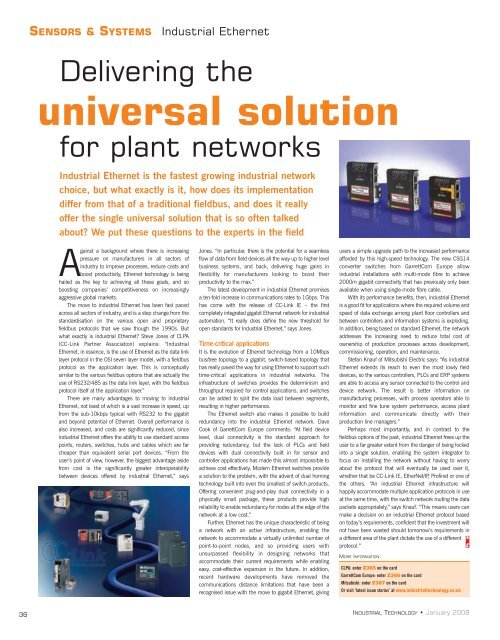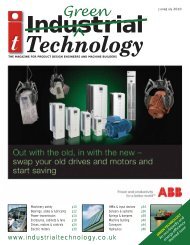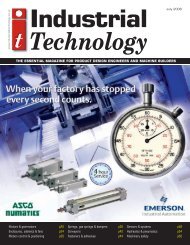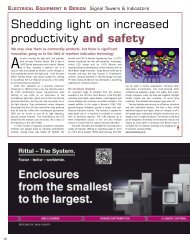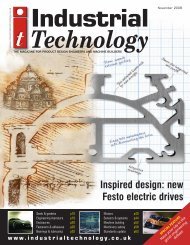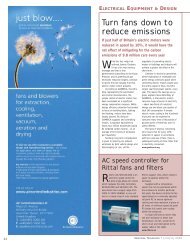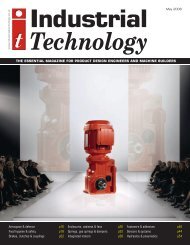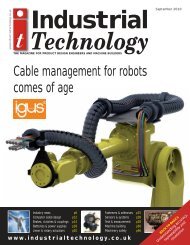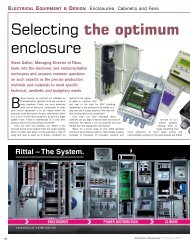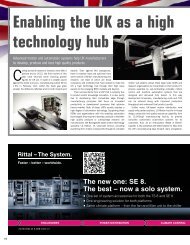IT Jan 2008 - Industrial Technology Magazine
IT Jan 2008 - Industrial Technology Magazine
IT Jan 2008 - Industrial Technology Magazine
You also want an ePaper? Increase the reach of your titles
YUMPU automatically turns print PDFs into web optimized ePapers that Google loves.
SENSORS & SYSTEMS<br />
<strong>Industrial</strong> Ethernet<br />
Delivering the<br />
universal solution<br />
for plant networks<br />
<strong>Industrial</strong> Ethernet is the fastest growing industrial network<br />
choice, but what exactly is it, how does its implementation<br />
differ from that of a traditional fieldbus, and does it really<br />
offer the single universal solution that is so often talked<br />
about? We put these questions to the experts in the field<br />
Against a background where there is increasing<br />
pressure on manufacturers in all sectors of<br />
industry to improve processes, reduce costs and<br />
boost productivity, Ethernet technology is being<br />
hailed as the key to achieving all these goals, and so<br />
boosting companies’ competitiveness on increasingly<br />
aggressive global markets.<br />
The move to industrial Ethernet has been fast paced<br />
across all sectors of industry, and is a step change from the<br />
standardisation on the various open and proprietary<br />
fieldbus protocols that we saw though the 1990s. But<br />
what exactly is industrial Ethernet? Steve Jones of CLPA<br />
(CC-Link Partner Association) explains: “<strong>Industrial</strong><br />
Ethernet, in essence, is the use of Ethernet as the data link<br />
layer protocol in the OSI seven layer model, with a fieldbus<br />
protocol as the application layer. This is conceptually<br />
similar to the various fieldbus options that are actually the<br />
use of RS232/485 as the data link layer, with the fieldbus<br />
protocol itself at the application layer.”<br />
There are many advantages to moving to industrial<br />
Ethernet, not least of which is a vast increase in speed, up<br />
from the sub-10kbps typical with RS232 to the gigabit<br />
and beyond potential of Ethernet. Overall performance is<br />
also increased, and costs are significantly reduced, since<br />
industrial Ethernet offers the ability to use standard access<br />
points, routers, switches, hubs and cables which are far<br />
cheaper than equivalent serial port devices. “From the<br />
user’s point of view, however, the biggest advantage aside<br />
from cost is the significantly greater interoperability<br />
between devices offered by industrial Ethernet,” says<br />
Jones. “In particular, there is the potential for a seamless<br />
flow of data from field devices all the way up to higher level<br />
business systems, and back, delivering huge gains in<br />
flexibility for manufacturers looking to boost their<br />
productivity to the max.”<br />
The latest development in industrial Ethernet promises<br />
a ten-fold increase in communications rates to 1Gbps. This<br />
has come with the release of CC-Link IE – the first<br />
completely integrated gigabit Ethernet network for industrial<br />
automation. “It really does define the new threshold for<br />
open standards for <strong>Industrial</strong> Ethernet,” says Jones.<br />
Time-critical applications<br />
It is the evolution of Ethernet technology from a 10Mbps<br />
bus/tree topology to a gigabit, switch-based topology that<br />
has really paved the way for using Ethernet to support such<br />
time-critical applications in industrial networks. The<br />
infrastructure of switches provides the determinism and<br />
throughput required for control applications, and switches<br />
can be added to split the data load between segments,<br />
resulting in higher performance.<br />
The Ethernet switch also makes it possible to build<br />
redundancy into the industrial Ethernet network. Dave<br />
Cook of GarrettCom Europe comments: “At field device<br />
level, dual connectivity is the standard approach for<br />
providing redundancy, but the lack of PLCs and field<br />
devices with dual connectivity built in for sensor and<br />
controller applications has made this almost impossible to<br />
achieve cost effectively. Modern Ethernet switches provide<br />
a solution to the problem, with the advent of dual homing<br />
technology built into even the smallest of switch products.<br />
Offering convenient plug-and-play dual connectivity in a<br />
physically small package, these products provide high<br />
reliability to enable redundancy for nodes at the edge of the<br />
network at a low cost.”<br />
Further, Ethernet has the unique characteristic of being<br />
a network with an active infrastructure, enabling the<br />
network to accommodate a virtually unlimited number of<br />
point-to-point nodes, and so providing users with<br />
unsurpassed flexibility in designing networks that<br />
accommodate their current requirements while enabling<br />
easy, cost-effective expansion in the future. In addition,<br />
recent hardware developments have removed the<br />
communications distance limitations that have been a<br />
recognised issue with the move to gigabit Ethernet, giving<br />
users a simple upgrade path to the increased performance<br />
afforded by this high-speed technology. The new CSG14<br />
converter switches from GarrettCom Europe allow<br />
industrial installations with multi-mode fibre to achieve<br />
2000m gigabit connectivity that has previously only been<br />
available when using single-mode fibre cable.<br />
With its performance benefits, then, industrial Ethernet<br />
is a good fit for applications where the required volume and<br />
speed of data exchange among plant floor controllers and<br />
between controllers and information systems is exploding.<br />
In addition, being based on standard Ethernet, the network<br />
addresses the increasing need to reduce total cost of<br />
ownership of production processes across development,<br />
commissioning, operation, and maintenance.<br />
Stefan Knauf of Mitsubishi Electric says: “As industrial<br />
Ethernet extends its reach to even the most lowly field<br />
devices, so the various controllers, PLCs and ERP systems<br />
are able to access any sensor connected to the control and<br />
device network. The result is better information on<br />
manufacturing processes, with process operators able to<br />
monitor and fine tune system performance, access plant<br />
information and communicate directly with their<br />
production line managers.”<br />
Perhaps most importantly, and in contrast to the<br />
fieldbus options of the past, industrial Ethernet frees up the<br />
user to a far greater extent from the danger of being locked<br />
into a single solution, enabling the system integrator to<br />
focus on installing the network without having to worry<br />
about the protocol that will eventually be used over it,<br />
whether that be CC-Link IE, EtherNet/IP, Profinet or one of<br />
the others. “An industrial Ethernet infrastructure will<br />
happily accommodate multiple application protocols in use<br />
at the same time, with the switch network routing the data<br />
packets appropriately,” says Knauf. “This means users can<br />
make a decision on an industrial Ethernet protocol based<br />
on today’s requirements, confident that the investment will<br />
not have been wasted should tomorrow’s requirements in<br />
a different area of the plant dictate the use of a different<br />
protocol.”<br />
MORE INFORMATION:<br />
CLPA: enter Z365 on the card<br />
GarrettCom Europe: enter Z366 on the card<br />
Mitsubishi: enter Z367 on the card<br />
Or visit ‘latest issue stories’ at www.industrialtechnology.co.uk<br />
36<br />
INDUSTRIAL TECHNOLOGY • <strong>Jan</strong>uary <strong>2008</strong>


